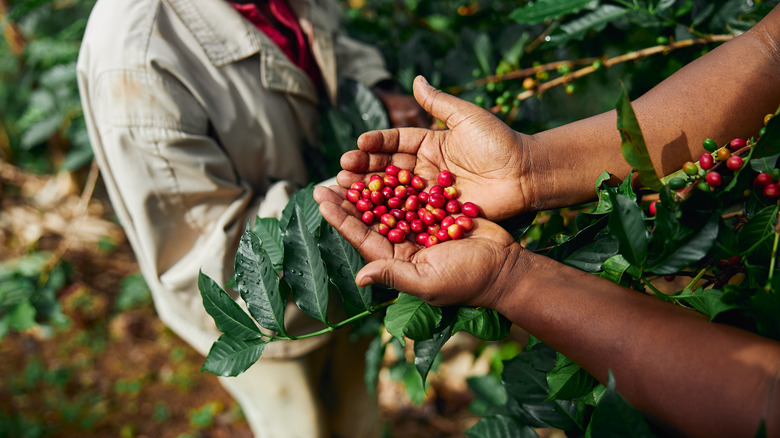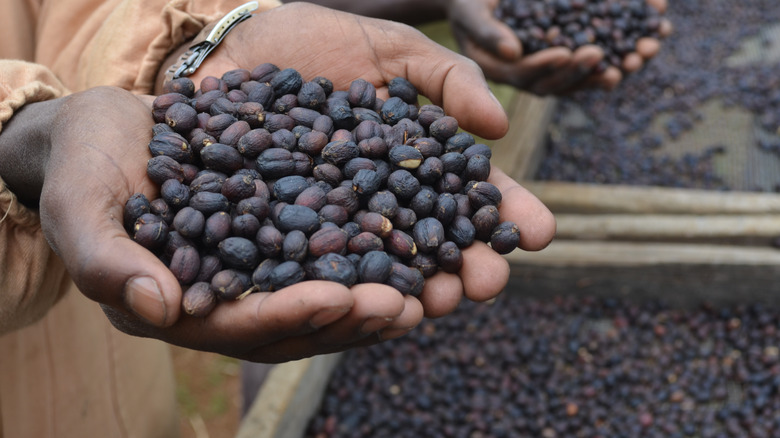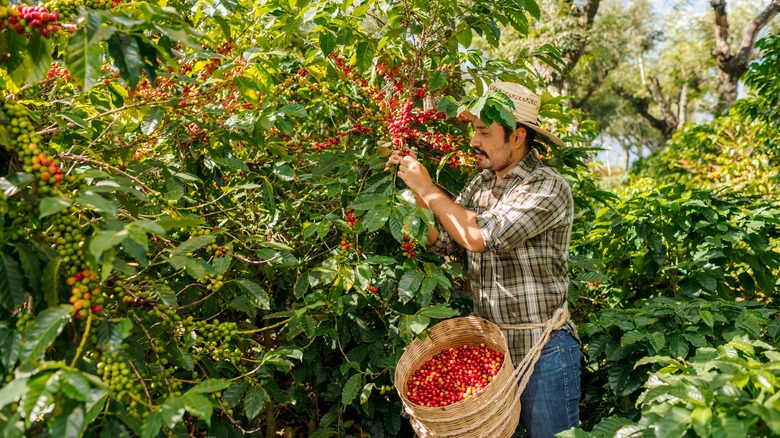The 3 Best Coffee Regions For The Tastiest Springtime Brew
While sipping a cup of joe, it can be easy to forget that those brewed ground beans are actually fruit seeds. And like any other crop, that makes the trees subject to seasonality. Coffee cherries are typically picked only once a year, after 2-3 months of ripening. The time frame of harvest depends on the origin — thankfully, there are fresh lots available all year round.
After harvest, there's added time for varying processing methods, milling, packaging, and shipping of the beans. Such logistics can add more months to the elapsed time from tree to cup. While some origins, like Ethiopian Yirgacheffes, do well with aging, most do not. Such a complicated chain means roasters must be adept at sourcing coffees to maximize their freshness.
Plus, there's added consideration in a brew's flavor for a specific time of the year — think fruity notes during springtime or beans predisposed to cold brew in summer. Thankfully, knowing what regions to look for seasonally can aid in procuring the most aromatic cup. So, what regions are best for a springtime brew? Ethiopia, Jamaica, and Central America. Here's why.
Kick off springtime brewing with Jamaican coffee
The first to mature in the season are Caribbean coffees. With abundant rainfall, elevated highlands, and favorable latitudes, the region is well-suited for generating a delicious cup. In fact, the French-controlled island of Martinique was where coffee was farmed for the first time in the Western Hemisphere.
Today, the majority of production occurs in Cuba, Haiti, Jamaica, and the Dominican Republic. Each country yields beans with distinct characteristics, however specifically, the Blue Mountain region of Jamaica generates acclaim. With high altitudes reaching over 2,000 meters, such a terroir develops coffees that are some of the most expensive sold worldwide.
Blue Mountain coffee exhibits a delectable flavor profile and is known for its lack of bitterness, balanced acidity, and bright taste. Typically put through a washed process, don't expect much funk — rather a sweet, slightly nutty flavor with an irresistible velvety mouthfeel. The ideal palette to kick off spring, the coffee's harvest window is cemented by the Blue Mountain coffee festival held in late March. Especially when lightly roasted, the coffee especially shines in pour-over methods.
Continue the season with Ethiopian coffee
With flowers blooming outside, Ethiopian coffees will deliver floral notes to your brew. A venerable coffee producer, the nation is where the caffeinating plant first emerged and continues to be an indispensable part of the culture today. With most production occurring in small lots surrounding the farmer's residence, there's an enormous amount of variation in bean type, processing, and resultant flavor.
Most harvesting of coffee in Ethiopia happens in November and December. Washed coffees, like Guji, Limu, and Yirgacheffe are the first to hit the shelves due to their shorter processing time. However, these varieties don't have a short shelf life, so no need to pounce on them quickly — Ethiopian coffee stores better than other bean types.
Due to the complex nature of Ethiopian coffee, there are varying flavors from lot to lot, even among a singular coffee type. For a cup well-suited to springtime palettes, Guji beans deliver a dependably bright flavor. Expect notes of citrus, fresh fruit, and a clean body reminiscent of tea — an ideal medley for when the sun finally parts through the clouds.
Finish springtime with a Central American brew
As the season progresses, Central American coffees will come into the season — first in Costa Rica, then northern varieties in Guatemala and Mexico. (Yes, we know Mexico isn't Central America, per most definitions.) Located smack in the middle of the ideal latitudes for coffee, there's an inexhaustible range of Central American coffees to choose from. The only common thread for beans here is complexity — think rich bodies, sweetness, spice, and lingering finishes. In fact, Panama's geisha variety is one of the world's most coveted beans.
Costa Rica is known for its density of coffee production, with eight separate regions squeezed into a country smaller than West Virginia. The country is famed for fruit-heavy coffee varieties, accentuated by the unique honey-processing method popular in the region. Additional complexity is integrated from the volcanic nature of the soil — a major contributor to Guatemalan coffee as well.
This Central American nation is one of the world's largest coffee producers by volume, but there's no sacrifice in quality despite the output. Guatemalan coffees are known for enthralling flavor palettes, combining cocoa undertones with bright acidity and floral finishes — all underpinned by a richer body that makes a perfect for a cold brew on a hot day.
And finally, Mexican coffees also rarely disappoint. Grown in 16 states across the North American nation, the regions of Oaxaca, Chiapas, Puebla, and Veracruz are the most established. Over 30 Mexican coffees scored high in the 'Cup of Excellence' tasting, which puts them up there with the world's best. Seek out innovative red bourbon varieties for an exceptionally fruit-forward cup.



